Factorising polynomials
| © 2007 Rasmus ehf og Jóhann Ísak Pétursson |
Factorising polynomials |
Lesson 1
Polynomial division and the Remainder Theorem.
Consider the function f(x) = 6x2 − 9x + 3 and choose a few values of x to make a table of values. Imagine that we
have been lucky enough to choose x = 1 and see that f(1) = 0.
If x = 1 then (x − 1) = 0 .
The fact that f(1) = 0 tells us that (x − 1) is a
factor of f(x).
If we assume (x−1) is a factor of f(x) we can also
show that
f(1) = 0:
f(x) = 6x2
− 9x + 3 = (unknown factor)(x − 1)
f(1) = 6
− 9 + 3 = (unknown factor)(1 − 1)
= 0
Now we need to divide 6x2 − 9x + 3 by x
− 1 to find the unknown factor.
We will now learn how to do this by comparing polynomial division to the way you have learned to do ordinary
numerical division.
Example 1
Numerical division:
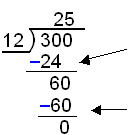 |
|
Polynomial division:
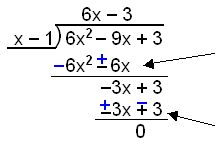 |
How often does x − 1 divide into 6x2 ? We only need to
ask how often does x divide into 6x2, or what do we have to
multiply x by to get 6x2. The answer is 6x. Now multiply
6x∙(x − 1) = 6x2 − 6x. |
|
Next move 3 down. Now divide
x−1 into −3x or ask what do we have to multiply x by to get −3x?
−3 |
f(x) = 6x2 − 9x + 3 can now be fully factorised:
f(x) = (6x
− 3)(x − 1) = 3(2x−1)(x − 1).
Example 2
We can also factorise 6x2 − 9x + 3 by using the formula for
quadratic equations to solve the equation 6x2 − 9x + 3 = 0.
The coefficients are a = 6, b = −9 and c = 3.
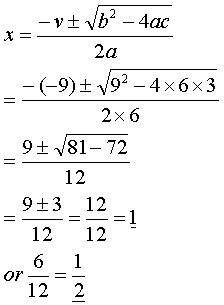
The solutions of the equation are x = 1 and x = ½ so the brackets (x − 1) and (x − ½) must both be
factors of 6x2 − 9x + 3. We get the following:
6x2 − 9x + 3 = 6(x − 1)(x − ½).
We must have 6 as a factor in order to get the correct result when we multiply the factors together.
This example gives us a rule for factorising quadratic functions that can be factorised into two brackets:
ax2 + bx + c = a(x − r1)(x − r2)
The values r1 and r2 are called the ROOTS of the function and are found by solving the corresponding quadratic
equation.
Example 3
We will now divide x3 − 6x2
+ 11x − 6 by x − 1 and use the result to factorise the
polynomial.
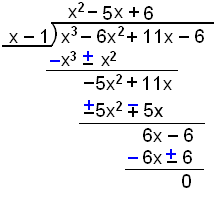 |
x divided into x3 gives x2 because x must be multiplied by x2 to get x3. x2(x − 1) = x3 − x2. Subtract x3 − x2 by changing the signs. |
|
Move 11x down. x divided into −5x2 gives −5x. −5x(x − 1) = −5x2 + 5x. |
|
|
Subtract −5x2 + 5x by changing the signs. Move −6 down. x goes 6 times into 6x. 6(x − 1) = 6x − 6. Subract |
The remainder is 0 which means that (x−1) is a factor of the polynomial. We can factorise the quadratic factor by
inspection or any other method we have previously studied.
x3 − 6x2 + 11x − 6 = (x2 − 5x + 6)(x − 1) = (x − 3)(x − 2)(x − 1)
Example 4
Now we’ll look at a more difficult example.
Divide the polynomial x3 − 4x + 3 by x − 1 and then factorise
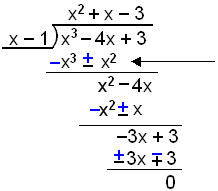 |
In this case we cannot subtract x2 and −4x, so both terms remain unchanged.
|
The remainder is 0 so x − 1 is a factor. It now
remains to factorise x2 +
x − 3. It can’t be done by inspection ( trial and error ) so we have to
use the quadratic formula.
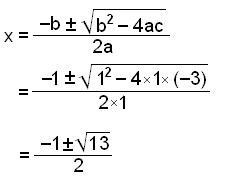
Fully factorised the polynomial will be:
x3
− 4x + 3 = (x2 + x
− 3)(x − 1)
![]()
Example 5
Now we’ll look at an example where the remainder is not 0.
Divide x3 + 4x2 + x + 1 by x + 1.
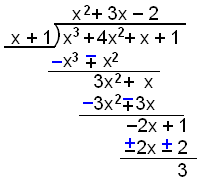
In this example the remainder is 3.

This way of writing the outcome is important in what follows:
From this example we can see the following general result:

Where f(x) is a polynomial that is divided by (x−a) and q(x) is the outcome of the division (quotient).
If we multiply both sides of this equation by x − a we get
f(x) = q(x)(x − a) + remainder
Now we will use this version of f(x) to calculate f(a).
f(a) = q(a)(a − a) + remainder
f(a) = q(x)∙0 + remainder
f(a) = remainder
This shows us that we can find the remainder when a polynomial is divided by x−a without doing any division.
This is called The
Remainder Theorem and says the following:
If the polynomial f(x) is divided by x
− a then the remainder
Example 6
Use the Remainder theorem to find the remainder when x3 + 4x2 + x + 1 is divided by x + 1.
If we can rewrite x + 1 as x−(−1) we can use the remainder theorem with a = −1.
f(−1) = (−1)3 + 4×(−1)2 + (−1) + 1
= −1 + 4 − 1 + 1
= 3
If you look at the previous example, Example 5, you will see that this agrees with the answer there.
Example 7
Finally we will use the Remainder theorem to find the remainder when x3 + 4x2 + x + 1 is divided by x − 1.
We use the Remainder theorem with a = 1 and
find the remainder when x3
+ 4x2 + x + 1 is divided by x − 1 by calculating f(1).
f(1) = 13 + 4×12 + 1 + 1
= 1 + 4 + 1 + 1
= 7
Try Quiz 1 on Factorising polynomials.
Remember to use the checklist to
keep track of your work.